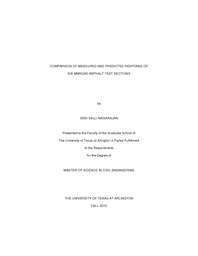
ATTENTION: The works hosted here are being migrated to a new repository that will consolidate resources, improve discoverability, and better show UTA's research impact on the global community. We will update authors as the migration progresses. Please see MavMatrix for more information.
Show simple item record
| dc.contributor.author | Nagarajan, Veni Valli | en_US |
| dc.date.accessioned | 2013-03-20T19:12:40Z | |
| dc.date.available | 2013-03-20T19:12:40Z | |
| dc.date.issued | 2013-03-20 | |
| dc.date.submitted | January 2012 | en_US |
| dc.identifier.other | DISS-11990 | en_US |
| dc.identifier.uri | http://hdl.handle.net/10106/11620 | |
| dc.description.abstract | The study, sponsored by MnRoad, aimed to compare the measured and predicted values of strains and stresses for six cells 33, 34, 35, 77, 78 and 79 of the third MnRoad experiments. Cells 33, 34 and 35 were constructed for studying the polyphosphoric acid study while cells 77, 78 and 79 for the fly-ash stabilization study, during 2007. Each cell is instrumented with three transverse strain gauges and three longitudinal strain gauges at the bottom of HMA layer while three pressure cells were located at the top of the subgrade layer to measure vertical compressive stress.The FWD deflection data collected in April and May 2009 was analyzed in Modulus 6.0 to back-calculate the moduli for the three layers of each cell. Then the back-calculated moduli were corrected for the time and temperature when sensor strain and stresses were recoreded. The corrected moduli were processed in Everstress 2.0 to calculate normal strains and stresses under the 80 KIP truck loading. The measured stress and strain values were obtained using the Peak-Pick software developed by MnRoad. The Everstress results were compared with the strain calculated by Thompson model. It was found that the Everstress strain values were 20 to 30% greater than the ones computed by the Thompson Model.The predicted transverse strains were in the same range as the measured transverse strains. The predicted longitudinal transverse strains were nearly 20% greater than the measured transverse strains. The predicted compressive stresses were nearly 20% lesser than the measured compressive stresses. The difference between predicted and measured transverse strains is smaller than that between the corresponding longitudinal strains. Both calculated and measured transverse strains are smaller than the corresponding longitudinal strains. | en_US |
| dc.description.sponsorship | Romanoschi, Stefan | en_US |
| dc.language.iso | en | en_US |
| dc.publisher | Civil & Environmental Engineering | en_US |
| dc.title | Comparison Of Measured And Predicted Response Of Six MnRoad Asphalt Test Sections | en_US |
| dc.type | M.S. | en_US |
| dc.contributor.committeeChair | Romanoschi, Stefan | en_US |
| dc.degree.department | Civil & Environmental Engineering | en_US |
| dc.degree.discipline | Civil & Environmental Engineering | en_US |
| dc.degree.grantor | University of Texas at Arlington | en_US |
| dc.degree.level | masters | en_US |
| dc.degree.name | M.S. | en_US |
Files in this item
- Name:
- Nagarajan_uta_2502M_11990.pdf
- Size:
- 5.277Mb
- Format:
- PDF
- Name:
- FWDResults.zip
- Size:
- 109.5Kb
- Format:
- Unknown
- Name:
- Everstress.zip
- Size:
- 18.71Kb
- Format:
- Unknown
- Name:
- Peak-pickResults.zip
- Size:
- 160.2Kb
- Format:
- Unknown
This item appears in the following Collection(s)
Show simple item record


